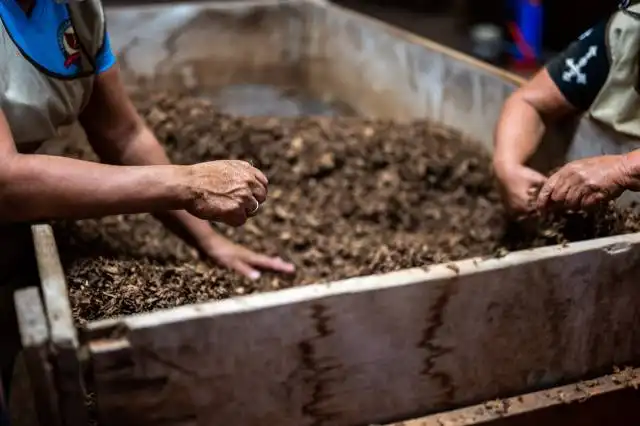Start a Wool Making Business
Spinning Joy: Transforming Fuzzy Wool into Cozy Comforts
| Updated


WOOL MAKING BUSINESS
Call it a 'merry-go-round' on a microscale, where everyone wins - the wool making business! In this cozy and fulfilling endeavor, you get to convert fluffy wool into warm, comforting textiles. Imagine being the maestro behind the curtains, turning plain sheep's wool into snuggly sweaters or robust rugs. In essence, a wool making business involves processing raw wool and crafting it into woolen products; it's all about adding value to food-for-grazers and transforming it into an essential commodity for humans. Let's just say, when pursued passionately, you and your future customers both end up being 'wrapped in joy'!
Jump to Business Plan
RELATED BUSINESS IDEAS
Browse ALL Sustainability & Eco-Friendly Initiatives Business Ideas
Discover Your Perfect Domain
Unlock the door to your online success with our hand-picked selection of premium domain names. Whether you're starting a new venture or rebranding an existing one, the right domain can set the tone for your digital presence. Browse through our curated list, each with its unique potential to enhance your brand's visibility and credibility.
WOOL MAKING MINI BUSINESS PLAN
This a quick reality check to help you identify the strengths and weaknesses of your business concept before you dive in.
Expected Percent Margin:
- Gross Margin: 40-50%
- Net Profit Margin: 15-25%
Earnings Expectations:
- Daily Earnings: $100 - $250
- Weekly Earnings: $700 - $1,750
- Monthly Earnings: $3,000 - $7,500
- Annual Earnings: $36,000 - $90,000
Actions to Hit Those Numbers:
Supply and Production:
- Initial Investment: At least $10,000 - $20,000 for sheep, shearing equipment, and processing machinery.
- Herd Management: Maintain a healthy herd of at least 20-30 sheep.
- Shearing Frequency: Shear your sheep at least twice a year.
Marketing and Customer Acquisition:
- Website and Social Media: Update frequently with appealing visuals and details reflecting quality and craftsmanship.
- Craft Shows/Farmer's Markets: Regular participation for directly reaching potential customers.
- Wholesale Partnerships: Reach out to local businesses, craft stores, and online marketplaces where your wool can be sold.
Sales and Customer Experience:
- Pricing Strategy: Price your product competitively but fairly considering your work and the quality of the wool.
- Customer Service: Provide responsive and helpful service to navigate customer inquiries and issues.
Cost Control:
- Sheep Care: This includes cost of feed, veterinary expenses, and housing maintenance. Should be less than 25% of expected monthly sales.
- Utilities and Maintenance: Budget this around $200-$400 per month for keeping your shearing and processing equipment in good condition.
Business Operations:
- Processing Volume: Ensure you're processing all of the wool your herd produces to maximize profit.
- Product Diversification: Diversify to other related products like wool yarn, dyed wool, and wool blankets for added income.
Please keep in mind, for a more accurate picture, you'll need a personalized business plan or financial analysis based on your specific circumstances and local market conditions.
NOT WHAT YOU HAD IN MIND? Here are more ideas



Browse ALL Sustainability & Eco-Friendly Initiatives Business Ideas
Grab Your Business Website Name
Before you get caught up in the whirlwind of setting up your business, invest in a domain name. It's a small but significant step that lays the foundation for your brand and makes it easier for customers to find and trust you. Just like you wouldn't build a house without securing the land first, don't build a business without securing your domain name.
"Why? Can't that wait?" Here's why it shouldn't
Step 1: Determine if Starting a Wool Making Business is Right for You
Breakdown of Startup Expenses
Before starting a wool making business, it is important to understand the associated costs. This includes the cost of materials, such as wool, needles, and other supplies. It also includes the cost of equipment, such as looms, spinning wheels, and other tools. Additionally, there may be costs associated with renting a space, marketing, and insurance. It is important to consider all of these costs and determine if the business is financially feasible.
Breakdown of Ongoing Expenses
After the startup costs have been considered, it is important to think about the ongoing expenses associated with running a wool making business. This includes the cost of materials, such as wool and other supplies. It also includes the cost of equipment maintenance and repairs, as well as the cost of any utilities associated with the business. Additionally, there may be costs associated with marketing, advertising, and insurance. It is important to consider all of these costs and determine if the business is financially feasible.
Examples of Ways to Make Money
Once the startup and ongoing expenses have been considered, it is important to think about ways to make money. This includes selling handmade items, such as hats, scarves, and sweaters. It also includes selling supplies, such as wool and other materials. Additionally, there may be opportunities to teach classes or workshops, or to offer custom services, such as spinning or weaving. It is important to consider all of these options and determine which ones are the most profitable.
Step 2: Name the Business
When it comes to naming a business, it is important to choose a name that is memorable, recognizable, and reflects the brand. It is also important to make sure the name is not already taken. It is a good idea to brainstorm a list of potential names and then research them to make sure they are available. Additionally, it is important to make sure the domain name is available. It is also a good idea to check the trademark database to make sure the name is not already taken. Once the name is chosen, it is important to register the business name with the state and obtain any necessary permits and licenses.
Step 3: Create a Business Plan
Creating a business plan is an important step in starting a wool making business. The business plan should include a description of the business, a market analysis, a competitive analysis, a description of the products and services, a marketing plan, an operations plan, a management plan, and a financial plan.
The description of the business should include the mission statement, the purpose of the business, the target market, and the location of the business. The market analysis should include an analysis of the current market, the potential market, and the target market. The competitive analysis should include an analysis of the competitors and their strengths and weaknesses.
The description of the products and services should include the types of wool products and services that the business will offer and the pricing structure. The marketing plan should include the strategies and tactics that will be used to promote the business and the products and services. The operations plan should include the processes and procedures that will be used to produce the products and services.
The management plan should include the organizational structure of the business, the roles and responsibilities of each position, and the qualifications of the personnel. The financial plan should include the startup costs, the ongoing expenses, and the projected income.
Step 4: Obtain Licenses and Permits
When starting a wool making business, it is important to make sure that all licenses and permits are obtained before beginning operations. Depending on the location of the business, the type of licenses and permits required may vary. Generally, businesses will need to obtain a business license, a seller’s permit, and any other licenses or permits that may be required by the state or local government. Additionally, businesses may need to obtain a zoning permit if the business is located in an area that requires one. It is important to research the specific requirements for the area in which the business is located.
How to Obtain Licenses and Permits
In order to obtain the necessary licenses and permits, the business owner should contact the local government offices to determine what is required. Generally, the local government offices will have a list of the necessary licenses and permits that must be obtained. Additionally, the local government offices will have information on how to apply for the licenses and permits. The business owner should make sure to read the instructions carefully and submit all required documents in order to obtain the licenses and permits.
Cost of Licenses and Permits
The cost of the licenses and permits will vary depending on the location of the business. Generally, the cost of the licenses and permits will be a one-time fee. Additionally, the cost of the licenses and permits may be subject to change over time. It is important to research the cost of the licenses and permits before applying for them.
Benefits of Obtaining Licenses and Permits
Obtaining the necessary licenses and permits is important for any business. Having the proper licenses and permits will ensure that the business is operating legally and can help protect the business from any potential legal issues. Additionally, having the proper licenses and permits will help to ensure that the business is in compliance with any local or state laws.
Step 5: Find the Right Suppliers
Finding the right suppliers is essential for any business. Quality suppliers can provide the necessary materials and resources needed to make a successful wool making business. When searching for suppliers, it is important to consider the cost, quality, and reliability of the products they offer. Additionally, it is important to research the reputation of the suppliers and make sure they have a good track record of delivering quality products on time. To find the right suppliers, it is important to ask for recommendations from other wool makers, search online, and attend trade shows. Additionally, it is important to read reviews and ask for samples before committing to a supplier.
Tips on Negotiating Prices
Once you have identified a few potential suppliers, it is important to negotiate prices. Negotiating prices can help you get the best deal possible and ensure that you are getting quality products at a reasonable price. When negotiating prices, it is important to be prepared and have a clear understanding of what you need and what you are willing to pay. Additionally, it is important to be flexible and open to compromise. It is also important to be aware of the market rate for the materials you need and be prepared to walk away if the supplier is not willing to meet your needs.
Step 6: Set Up a Business Location
When deciding on a business location, there are several factors to consider. First, consider the cost of renting or buying a space. It is important to factor in the cost of utilities, taxes, and insurance when determining the cost of the space. Second, consider the zoning laws of the area. Depending on the type of business, there may be restrictions on the type of building or area that can be used. Third, consider the accessibility of the location. It is important to choose a location that is easily accessible for customers and employees. Finally, consider the visibility of the location. It is important to choose a location that is visible to potential customers.
Step 7: Obtain Licenses and Permits
Types of Licenses and Permits
When starting a wool making business, it is important to obtain the necessary licenses and permits. Depending on the state, there may be different types of licenses and permits that are required. For example, a business license may be required to legally operate the business. Additionally, a sales tax permit may be needed if the business will be selling products. Furthermore, a zoning permit may be required if the business will be operating in a certain area. Finally, a health permit may be required if the business will be selling food products. It is important to research the specific licenses and permits that are required for the business.
Step 7: Market Your Business
Marketing your business is essential to its success. There are many effective ways to market your wool making business. One of the most effective ways is to create a website or blog to showcase your products and services. Additionally, you can use social media platforms such as Facebook, Twitter, and Instagram to reach potential customers. You can also use email marketing, search engine optimization (SEO), and pay-per-click (PPC) advertising to reach more customers. Additionally, you can create a referral program to encourage existing customers to share your products and services with their friends and family.
Networking
Networking is another great way to market your wool making business. You can attend local business events, join professional associations, and participate in online forums related to your industry. Additionally, you can reach out to potential customers directly by cold calling or emailing them. You can also use direct mail to reach potential customers.
Advertising
Advertising is another great way to market your wool making business. You can use traditional print media such as newspapers, magazines, and flyers to reach potential customers. Additionally, you can use radio, television, and billboard advertising to reach more customers. Additionally, you can use online advertising such as Google Ads and Facebook Ads to reach potential customers.
Promotions
Promotions are a great way to market your wool making business. You can offer discounts, coupons, and free samples to attract more customers. Additionally, you can offer loyalty programs and referral programs to encourage customers to come back and refer their friends and family. You can also host special events such as workshops and seminars to attract more customers.
Step 8: Set Up an Accounting System
Setting up an accounting system is an important step for any business. An accounting system will help you manage your finances, track your income and expenses, and make sure you are paying taxes correctly. It will also help you keep track of your profits and losses. Having an accounting system in place will help you make informed decisions about your business and will help you stay organized.
Types of Accounting Systems
There are several types of accounting systems available. You can choose from manual systems, computerized systems, or cloud-based systems. Manual systems involve keeping track of your finances on paper, while computerized systems involve using software to track your finances. Cloud-based systems are hosted online and are accessible from any device with an internet connection.
Choosing an Accounting System
When choosing an accounting system, it is important to consider your business’s needs. If you are a small business, a manual system may be sufficient. However, if you are a larger business, you may need a more sophisticated system. It is also important to consider the cost of the system, as well as the features it offers.
Setting Up an Accounting System
Once you have chosen an accounting system, you will need to set it up. This process involves entering your financial data into the system, such as income and expenses, as well as setting up any necessary accounts. You may also need to set up any necessary tax accounts. Once the system is set up, you will be able to track your finances and make informed decisions about your business.
Step 9: Hire Employees
When it comes to hiring employees, it is important to find the right people who are passionate about wool making and have the skills necessary to help the business succeed. It is important to create a job description that outlines the job duties, the salary, and the qualifications needed for the position. It is also important to conduct background checks on potential employees to ensure they are the right fit for the job. Additionally, it is important to create a safe and comfortable work environment for employees. This should include providing them with the necessary tools and resources to do their job and creating a culture of respect and appreciation.
Benefits of Hiring Employees
Hiring employees can be beneficial for a wool making business. Employees can help with the day-to-day operations of the business, such as managing customer orders, creating marketing materials, and handling customer inquiries. Employees can also help to expand the business by bringing in new ideas and perspectives. Additionally, having employees can help to free up the business owner’s time, allowing them to focus on other aspects of the business.
Finding Employees
Finding the right employees can be a challenge. It is important to use a variety of methods to find potential employees, such as job postings, referrals, and networking. Additionally, it is important to use social media to reach a wider audience. It is also important to create a website for the business to showcase the products and services offered and to attract potential employees.
EXPLORE MORE CATEGORIES
Browse ALL Business Idea Categories
TAKE THE NEXT STEPS










